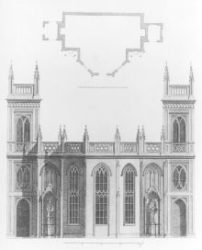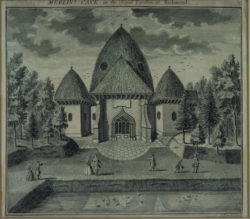Date/Time
Date(s) - Monday 9 December 2019
8:00 pm - 9:45 pm
Location
Duke Street Church
Categories No Categories
SDd you know that as well as having a pagoda, Kew Gardens used to have a mosque and a Gothic cathedral? Susanne Groom took us on a tour of the lost 18th-century buildings and follies in Kew Gardens, considering why they may have been built and speculating on the effects they produced on those who viewed them.
The Royal Botanic Gardens at Kew is today a World Heritage site and probably the most famous and important botanic garden in the world. Its botanic origins date back to the 18th century, but less in evidence today is the large area of the gardens which provided a royal pleasure park of historic world architecture. Styles of garden buildings in this theme park ranged from newly discovered ancient ruins of the Middle East to those of classical Greece and Rome, from a Chinese temple to a Gothic cathedral, increasing in number and variety over three decades of the mid-18th century. Other stately gardens had idiosyncratic follies, but none to eclipse those at Kew.
Various indications of the lost Pleasure Gardens at Kew survive, notably the Orangery, the Temples of Aeolus, Bellona and Arethusa and, of course, the most famous, the Pagoda. Originally there were over 20 decorative buildings in the garden, mostly designed by William Chambers. They were, if you like, a Grand Tour to be made in an afternoon and made specifically for the one aristocratic person greatly interested in architecture and travel, who most wanted to go on a Grand Tour, and who, because of his position as heir to the throne, was unable to do so. This person was the Prince of Wales, later George III.
So, what did these buildings look like? Who masterminded them? What functions did they serve? Who paid for them? And what happened to them?
These are some of the questions that Susanne addressed in her talk.
Susanne Groom lives in Kew and is a former curator at Historic Royal Palaces. She co-authored At the King’s Table: Royal Dining Through the Ages, which was the subject of her talk to us in December 2013, Discover the Gardens and Kew Palace: The Official Illustrated History. She gave a talk to us in October 2018 on the Hanoverian royal family’s 300 years at Richmond and Kew.
Susanne’s talk was followed by our customary seasonal party, with wine, soft drinks and nibbles.
Simon Fowler reports on Susanne’s talk
Susanne’s well-illustrated talk looked at the architecture of Kew Gardens during its Royal heyday in the mid-eighteenth century, particularly the work undertaken by George II, George III and Frederick Prince of Wales. Susanne suggested that many of these buildings were really a sort of theme park designed to keep George III, then Prince of Wales, away from the bright lights of London.
George II’s connection with what became the gardens began when he moved to the long-demolished Richmond Lodge in the Old Deer Park. His wife, Queen Caroline, turned the grounds into one of the first landscaped gardens in England. The Lodge was demolished by George III who preferred to live at the White House.
There were many buildings that no longer exist within the site of what became Kew Gardens. Susanne mentioned specifically the Temple of English Worthies, which was designed by William Kent. It is similar to the Hermitage at Stowe.
Another structure, that would have been fascinating to visit had it survived, was Merlin’s Cave – another design by William Kent – which contained a range of waxworks on an English theme.
The Temple of the Sun, near the Orangery, was destroyed in 1916, by the fall of a Cedar of Lebanon tree. Other temples, such as the Temple of Pan, the Chinese Temple, and the Temple of Aeolis were all painted in brilliant colours with grotesque statues and effects. Near where the Japanese garden is today was the Alhambra, an exotic Gothic cathedral made entirely of wood.
Within the area around Kew Palace, then known known as the Dutch House, there was the White House, a complex of buildings which extended almost to where the Orangery is today. It was originally a Tudor building owned by the Capel family. The building was remodelled by Frederick Prince of Wales in the 1730s with help from William Kent, to house his sisters.
On Frederick’s death in 1751 his widow Augusta continued to develop the gardens. For a short while on the site between the Dutch House and the river was an unfinished castellated palace surrounded by an exotic garden. This was meant for George III, but was blown up by his son George IV who much preferred his own make believe at Brighton Pavilion.

